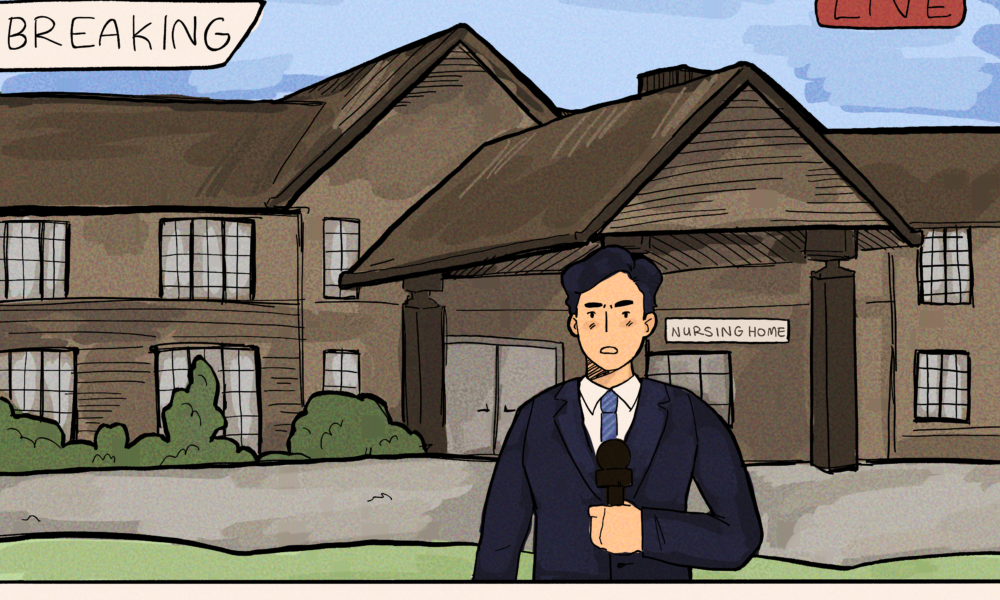With the prevalence of cosmetic procedures, skincare products, and diets aimed at reducing the effects of aging, and with tech entrepreneurs spending millions annually in the hopes of reversing the process, aging is often seen as something to be feared and prevented at all costs. Five years ago, when the first wave of the COVID-19 pandemic made its way to Canada, it disproportionately struck older adults, specifically those in long-term care homes: Around 80 per cent of COVID-19 deaths occurred in adults aged 65 and older. Although mainstream media heavily reported on the deaths of older individuals, their portrayal reflects our society’s underlying negative sentiment towards older adults and aging.
In a recent paper published in Ageing & Society, Oluwagbemiga Oyinlola, medical social worker and doctoral candidate at McGill’s School of Social Work, and his colleagues examined how the media’s portrayal of COVID-19 deaths in long-term care homes often employed a tragedy narrative that elicited a sense of pity for older adults while simultaneously trivializing their deaths.
Examining news outlets’ portrayals of older adults during the pandemic provides deeper insight into societal attitudes toward this age group. Media coverage often depicted older adults as vulnerable and helpless, reflecting society’s tendency to view older people as a burden. This portrayal not only reinforced pre-existing negative stereotypes regarding older adults but also shaped public perception, in turn influencing the public health response.
“[Articles] were written within the lens of a humanitarian crisis and tragedy rather than through the lens of action and really supporting older adults to grow and thrive in long-term care,” Oyinlola said in an interview with The Tribune.
To analyze media reporting, Oyinlola and his colleague, postdoctoral researcher Sabrina Lessard, independently reviewed 74 articles on long-term care home residents during the pandemic, with the sample drawing from both Ontario and Quebec. Their analysis, in collaboration with their supervisor Professor Tamara Sussman, helped uncover insights into societal attitudes towards older adults as reflected in the media.
“The [sources in the] reporting mostly came from government officials and those working in long-term care. Although the main focus was older adults, they were totally excluded when it came to hearing their own experience,” Oyinlola added.
The fact that reporting on older individuals relied almost completely on the perspectives of workers and family members, rather than the individuals themselves, speaks volumes on how older adults are viewed as an “othered” group that requires pity instead of as integral members of society.
“Excluding older adults as a separate entity is a tragedy and form of ageism in itself and stigmatizes them as a separate group which needs humanitarian [support],” Oyinlola said.
Additionally, media coverage primarily focused on those living in long-term care homes, despite only four per cent of older individuals residing in these facilities. This focus, portraying the deaths within these centres as a spectacle and tragedy, overshadowed the broader issues facing older adults during the pandemic.
“COVID-19 taught us very explicitly that ageism is a highly embedded and internalized feeling about aging and being old,” Sussman remarked. “The fear is so high for all of us that we are willing to do everything we can to ‘other’ and [exclude] older adults as a way of reassuring ourselves from our own anxiety towards aging.”
By framing these events as an inevitable tragedy rather than addressing the situation as one that requires protective action from both governments and the general public, older adults were effectively alienated from the wider community.
The next stage of Oyinlola’s research aims to explore the first-hand experiences of older adults during the pandemic. To properly address the issues facing older adults in Canada moving forward, we must unpack our negative perceptions of aging and reconsider our obsession with youth.









